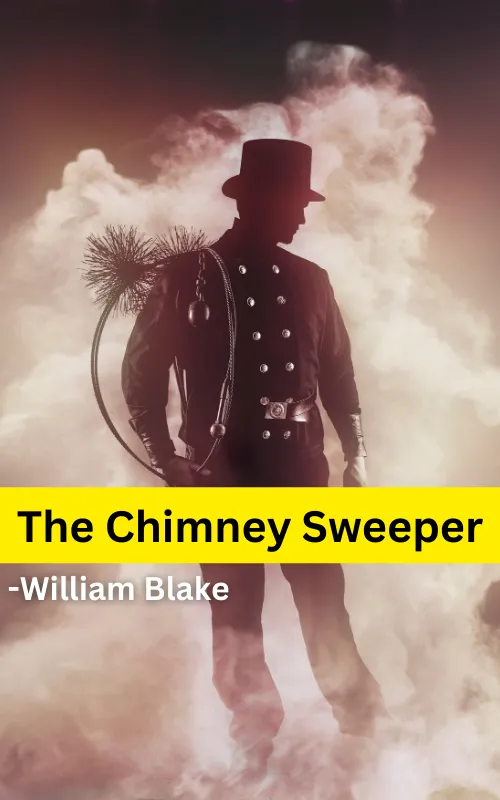About Poem: The Chimney Sweeper
| Titles | The Chimney Sweeper (from “Songs of Innocence”) |
| Author | William Blake |
| Date written & published | 1789 |
| Subject | The hardships and suffering of child chimney sweeps |
| Type of poem | Lyric poem |
| Literary techniques | Literary techniques |
| Date of Composition | Late 18th century (published in 1789 and 1794) |
| Genres | Poetry, Social Critique, Lyric |
| Themes | Child Labor, Exploitation, Innocence, Experience, Religion, Social Critique, Hope |
| Structure | Short poems, each with 6 quatrains (four-line stanzas) |
| Tone | Bleak, somber, and hopeless |
| Language | Simple and direct in “Innocence,” and more complex and ironic in “Experience” |
Themes: The Chimney Sweeper
The themes of “The Chimney Sweeper” by William Blake are:
- Child Labor and Exploitation ➤ The poem highlights the harsh reality of child labor in the 18th century, focusing on the exploitation of young chimney sweepers.
- Innocence and Experience ➤ It contrasts the innocence of childhood with the harsh experiences of life, suggesting how society can corrupt the purity of youth.
- Social Critique ➤ The poem criticizes the societal and religious institutions that allow child labor to persist, emphasizing the need for change and compassion.
- Hope and Liberation ➤ Despite the bleakness, the poem hints at hope and the possibility of spiritual liberation for the oppressed children.
The Chimney Sweeper Summary & Analysis
Stanza 1
When my mother died I was very young, And my father sold me while yet my tongue Could scarcely cry “weep! weep! weep! weep!” So your chimneys I sweep & in soot I sleep.
The speaker describes how he was sold into child labor at a very young age after his mother died. He now works as a chimney sweep, a dangerous and dirty job.
Stanza 2
There’s little Tom Dacre, who cried when his head, That curled like a lamb’s back, was shaved, so I said, “Hush, Tom! never mind it, for when your head’s bare, You know that the soot cannot spoil your white hair.”
The speaker tells the story of his friend Tom Dacre, who had his head shaved when he first started working as a chimney sweep. The speaker tries to comfort Tom by telling him that the soot cannot spoil his white hair, which is a symbol of his innocence.
Stanza 3
And so he was quiet, & that very night, As Tom was a-sleeping he had such a sight! That thousands of sweepers, Dick, Joe, Ned, & Jack, Were all of them locked up in coffins of black.
Tom has a dream in which he sees thousands of chimney sweeps locked up in coffins of black. This dream symbolizes the death and suffering of child chimney sweeps.
Stanza 4
And by came an Angel who had a bright key, And he opened the coffins & set them all free; Then down a green plain, leaping, laughing they run, And wash in a river and shine in the Sun.
An angel comes and sets the chimney sweeps free from their coffins. They run down a green plain and wash in a river, where they are transformed into innocent children again.
Stanza 5
Then naked & white, all their bags left behind, They rise upon clouds, and sport in the wind; And the Angel told Tom, if he’d be a good boy, He’d have God for his father & never want joy.
The chimney sweeps rise up into the clouds and sport in the wind. The angel tells Tom that if he is a good boy, he will have God for his father and never want joy. This suggests that there is hope for child chimney sweeps, even in the midst of their suffering.
Stanza 6
And so Tom awoke; and we rose in the dark, And got with our bags & our brushes to work. Though the morning was cold, Tom was happy & warm; So if all do their duty, they need not fear harm.
Tom wakes up from his dream and goes back to work. He is happy and warm, even though the morning is cold. This suggests that Tom has found hope and strength in his dream.
FAQs: The Chimney Sweeper
What is the message of the poem the chimney sweeper?
The message of the poem “The Chimney Sweeper” is that child labor is wrong and that there is hope for a better world.
Who is suffering in the chimney sweeper?
The chimney sweeps are suffering in the poem.
What is the symbolic significance of the angel in Blake’s poem The Chimney Sweeper?
The angel in Blake’s poem “The Chimney Sweeper” symbolizes hope and salvation for the child chimney sweeps.
What point of view is The Chimney Sweeper written in?
The poem is written in the first person point of view, from the perspective of a young chimney sweep.
What does Tom’s hair symbolize?
Tom’s hair symbolizes his innocence.
What are the social issues in The Chimney Sweeper?
The social issues in The Chimney Sweeper are child labor and exploitation.
Why is the poem named The Chimney Sweeper?
The poem is named “The Chimney Sweeper” because it is about the life and experiences of a young boy who works as a chimney sweep.










![The Catcher In The Rye Summary, Themes & Characters [by J. D. Salinger] The Catcher In The Rye Summary, Themes & Characters [by J. D. Salinger]](https://atozsummary.com/wp-content/uploads/2023/06/The-Catcher-In-The-Rye-Summary-Themes-Characters-by-J.-D.-Salinger.webp)
